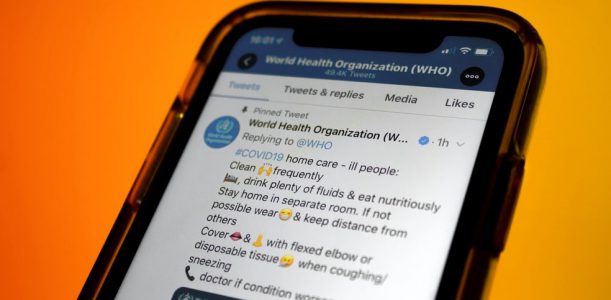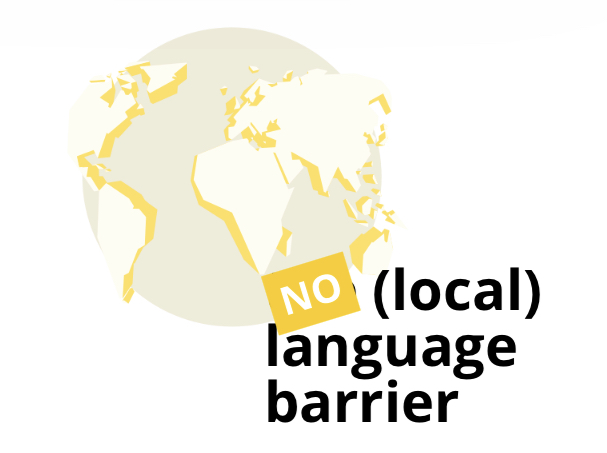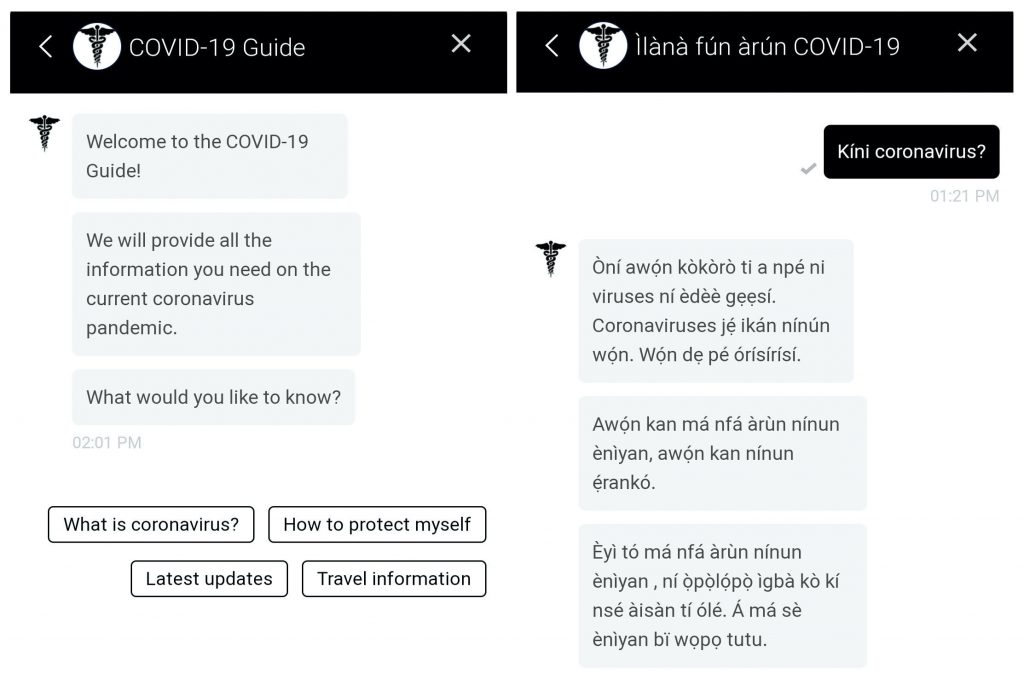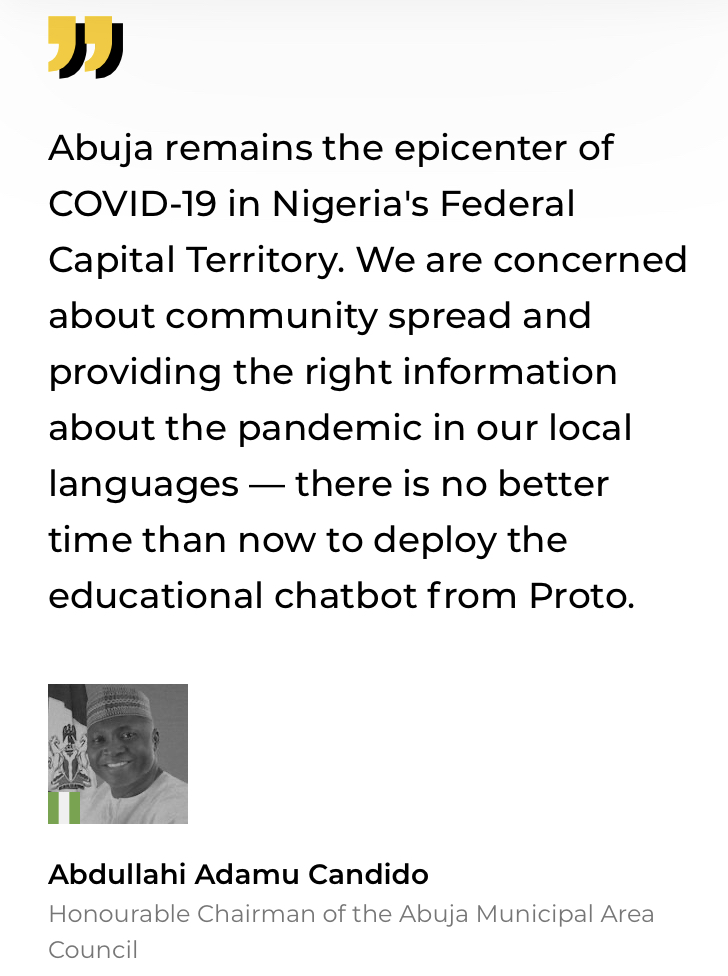Since the start of the COVID-19 pandemic, chatbots have played an important role in sharing awareness about COVID-19 via messaging apps.
In this blog post, I will tackle the topic of “digital divides” again, this time discussing Proto – a Canadian company that recognizes the challenges faced by many countries in the Global South when it comes to disseminating reliable and accurate information to citizens during the pandemic, often due to long-standing language barriers.
At this time, Proto has deployed their COVID-19 awareness chatbots to healthcare service providers in the Global South, all free of charge. The company also encourages anyone that would like access to their technology to contact them so they can work together to quickly deploy the chatbots, which are available in under-resourced and mixed languages.
WHAT IS THE PURPOSE OF A CHATBOT?
A chatbot is a digital, conversational interface that uses a messaging platform, social network, or mobile chat solution for its conversations. Chatbots can come in a simple form, where keywords are picked up from customers’ inquiries to deliver pre-programmed answers, while more sophisticated “intelligent” chatbots are powered by artificial intelligence (AI) and machine learning (ML).
AI chatbots can use specialized language processing solutions to create responses and conversations and actively learn from the interactions they have with customers. Natural language processing (NLP) is essentially a form of AI that focuses on analyzing the human language to create conversations within specific contexts, and can even help with accurate messaging prompts by providing spell checking, autocomplete, and autocorrect functions.
Unlike most chatbot vendors, Proto has its own Natural Language Processing engine. This allows us to rapidly refine the AI performance in niche languages across emerging markets.
Proto CEO Curtis Matlock
Proto’s HermesAI™ – the company’s natural language processing engine – has raised the standard for conversational AI in non-English markets. The proprietary software allows chatbots to understand phrases with two or more languages being mixed, such is the case with “manglish” in Malaysia or “chinglish” (slang for spoken or written English that is influenced by the Chinese language).
WHAT IS PROTO DOING?
As previously discussed, to expand service, Proto rapidly developed a COVID-19 education chatbot compatible with SMS-capable phones, in addition to being available over popular mobile messaging apps.
The chatbot currently offers localized Natural Language Understanding for Swahili, Igbo, Yoruba, French, Arabic, Malay, and Tagalog. It has also been customized for under-resourced and mixed languages, including Xhosa, Zulu, Hausa, and Afrikaans.
As an added bonus, in order to fight misinformation, Proto recently delivered the multilingual educational chatbots to African health service providers during the COVID-19 pandemic. As some of my colleagues have discussed in other blog posts, we often hear about the gravity of the “infodemic” that has now plagued the world (on top of the COVID-19 pandemic).
Proto’s chatbots are available via Messenger, Whatsapp, Webchat, and SMS. They provide educational dialogue for checking symptoms, statistics related to the pandemic, and precautions related to various diseases, as prescribed by the World Health Organization and the Nigeria Centre for Disease Control (NCDC).
LANGUAGE AS A LONG-STANDING BARRIER
Let’s face it: language can and often has been a barrier to accessibility.
Countries in the Global South with a high proportion of “bottom-of-the-pyramid” citizens are often left out from many services widely available in the Global North for two key reasons: native languages are not supported and/or these mobile chatbots require messaging apps to be installed on compatible smartphones.
The COVID-19 crisis is having an extremely disruptive social and economic impact on some of the planet’s most vulnerable citizens.
Proto CEO Curtis Matlock
Consequently, linguistic barriers specifically can make it difficult to establish effective communication. Language can also be a barrier to collaborations or partnerships so much so that “in most cases…northern partners become the voice for southern actors whose language is too fragmented and particularistic to be globally legible” (Landau 2019: 27).
Furthermore, researchers in the Global South often cannot “package” their research and/or findings into “shiny, cleverly, packaged solutions” and their recommendations are often likely to “get overshadowed by global perspectives,” which forces them to eventually delegate their findings to partners in the Global North (Landau 2019: 32).
This is where the problem lies.
In Africa, digital technology is often described in terms of the digital divide – which is a major discrepancy between the Global North and the Global South when it comes to the ease of access to information and communications technology (ICT) for all users (Fuchs & Horak, 2008).
Working together, Proto and pan-African NGO organization Reformers of Africa are looking to improve access to COVID-19 healthcare knowledge and reduce misinformation among residents in African countries – including the previously-mentioned “bottom-of-the-pyramid” citizens who are historically marginalized and often overlooked in technology-driven solutions. As previously discussed, Proto recently delivered the multilingual educational chatbots to African health service providers during the COVID-19 pandemic in order to fight much of the misinformation that has been permeating throughout all areas of the globe.
At this time, the true impact and possible fallout still remains to be seen.
Data can now be shared in real time with practitioners such as doctors, medical staff, scientists, research labs all over the world thanks to AI.
Jan Kleijssen, Director of Information Society Action against Crime, Council of Europe
On the overall, the short and long-term impacts of the COVID-19 pandemic could very well jeopardize advancements in digital tools and artificial intelligence and constrain efforts in many countries in the Global South to reach digital development goals within the foreseeable future.
It is therefore essential now more than ever to develop accessible tools and deliver messaging that is accurate, timely, and wide-reaching. The information can then also be tailored to specific risks, languages, and cultural contexts (Beaunoyer, Dupéré & Guitton 2020). In spite of an uncertain and unstable digital landscape, Proto has identified a major gap in the accessibility of information and has delivered a quick, free solution to break down a long-standing barrier.
Only time will tell how effective and accessible this digital tool really is to the people who need it most. But if we can work together to break down long-standing barriers, aren’t we already on the right path?
REFERENCES:
Beaunoyer, E., Dupéré, S. & Guitton, M. J. (2020). COVID-19 and Digital Inequalities: Reciprocal impacts and mitigation strategies. Comput. Hum. Behav. 111, 106424.
Fuchs, C., & Horak, E. (2008). Africa and the Digital Divide. Telematics and Informatics, 25(2), pp. 99 – 116. https://doi.org/10.1016/j.tele.2006.06.004.
Landau, L. B. (2019). ‘Capacity, Complicity, and Subversion: Revisiting Collaborative Refugee Research in an Era of Containment.’ in McGrath, S. and Young, J. E. E. (ed.) Mobilizing Global Knowledge: Refugee Research in an Age of Displacement. Calgary: University of Calgary Press, pp. 25-43.





